
“Effective Weightloss” Section Overview
Weightloss is a topic that has some of the most misleading information available. Unfortunately, a lot of that misinformation was intentionally created to sell products or programs. In this section, I explain the simple facts about weightloss, & the simple method to achieve it. You’ll find out why “going on a diet” doesn’t work, & what does. You’ll also finally learn the truth about weightloss and exercise. I’ll also tell you the most important food to avoid, about the “Plate Method”, & about the inexpensive device you can buy that’ll boost your weightloss success.
Weightloss.
It’s amazing how much that problem plagues so many middle-aged men and women. Some of us had normal weight or were even slim in our younger days. But all of a sudden, around our mid-40’s, we start to pack on the extra weight.
Some of us just ignore it, like it’s not really there. Others just don’t care. But most of us don’t like it, and we have an interesting range of responses to this issue, from sort of watching what we eat at one end of the spectrum, to really putting full effort into diet and exercise at the other end.
A lot of us have tried going on different diets. But in the end, most of them fail. And then sometimes we feel like failures too.

Well, I’ve got some bad news and some good news.
The bad news is that almost all of the “diets” won’t work on a long-term basis. Sure, you can lose some weight on some diets, but many studies have shown that people usually just put the lost weight back on, and often times, even more. And after a lot of suffering in most cases.
The good news is that you don’t need to “go on a diet” to lose weight. You just need to eat sensible portions of healthy foods.
Data from a 2009 study showed that low fitness is responsible for 16 percent to 17 percent of deaths in the United States, while obesity accounts for only 2 percent to 3 percent, once fitness is factored out. Exercise reduces abdominal fat and improves health, even without weight loss. This suggests that overweight people should focus more on exercising than on calorie restriction.
“Going on a diet”, generally-speaking, doesn’t work. The idea of drastically cutting your caloric intake to lose weight is not the way to lose weight. One reason is that your body tries to maintain what it believes is your correct weight. Researchers know that just about anyone who deliberately loses weight — even if they start at a normal weight or even underweight — will have a slower metabolism when the diet ends.
So, let’s say that you’re eating 3,000 calories a day, are overweight, and should be eating only 2,500 calories a day. If you go on a diet and drop to 1,500 a day to lose weight, in many cases when you stop your diet, you won’t be able to go back to 2,500, because your metabolism will have slowed, and will likely stay slower. So you may have to stay on 2,000 calories a day.
In addition, if your weight is below your “set-point”, your body will also produce more hunger-inducing hormones and you will find eating more rewarding because your body believes that your set-point is where you should be.
Studies show that after about five years, 41 percent of dieters gain back more weight than they lost. Long-term studies show dieters are more likely than non-dieters to become obese over the next 1 to 15 years.
Even for athletes who start out fit and slim are subject to this problem. A 2006 study found that elite athletes who competed for Finland in such weight-conscious sports as boxing, weightlifting and wrestling were three times more likely to be obese by age 60 than their peers who competed in other sports. These athletes sometimes have to crash-diet to lose weight in order to compete in a certain weight class, and crash diets are not good for your body.
What you do need to do is to eat healthy foods in the proper amounts. The reason I say that you don’t need a weightloss program is because what you need isn’t a weightloss program; it’s a healthy lifestyle. It’s the one we should all naturally be living.
Here’s some more good news: you’re not going to have to go hungry! To some degree, you’ll be able to eat as much as you want. You’ll just have to change what it is you’re eating.
So instead of having those pork chops and a baked potato with about a ¼ pound of cheese on it (just kidding), maybe you’ll have a grain dish like barley with lots of yummy veggies in it and a tasty sauce. Or how about riced cauliflower & sweet potatoes (by Green Giant).
This is my summary: Eliminate sugar as much as possible, drop junk foods, replace them with healthy foods and exercise mainly for health, not for weight loss.
Let me explain in steps.
1) Limit Your Sugar Intake

Eliminate as much sugar as you can from your diet. Many studies show that eating sugar is not only really bad for your body, it leads to weight gain. Drop sodas, fruit juices, candies, donuts, pastries, and lot of other things with sugar in them, all of which provide minimal nutrition. The World Health Organization suggests an intake of no more than 25 grams of “added” sugar per day. I say “added” because that figure doesn’t include naturally-occurring sugars, such as the ones found in fruits. That having been said, though, too much fruit juice (not whole fruits) aren’t good for you either.
“25 grams”. To put that in perspective, a Classic Coke has 39 grams of added sugar in it, a Mars bar has 31 grams, a Starbuck’s Latte has 17 grams and a Dunkin’ Donut bismark has 37 grams. Look at sugar as an occasional treat in moderation. I like Trader Joe’s jellybeans. They have a really fruity flavor and only 5 grams of added sugar in 6 beans, with all-natural fruit flavors. Just one or two can satisfy your sweet tooth.
2) Cut out the junk food
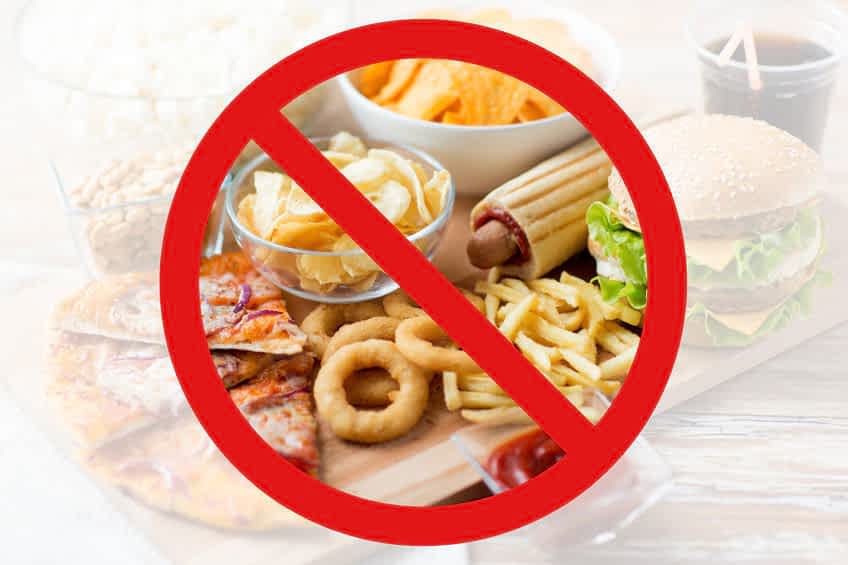
Eliminate junk food from your diet. You know which ones I mean. Besides eliminating sugar, drop refined foods with empty calories. By “empty calories” I mean foods that do not provide good nutrition for you, such as potato chips, French fries, donuts, white bread, white pasta, etc. Sure, you can have a few chips even a couple of times a day, and a reasonable serving of white pasta from time to time, but more as a “treat”, than as a standard part of your diet.
3) Replace junk food with whole food

As you move closer to a healthy diet, replace junk foods with whole foods, made with things like whole grains, beans, nuts, seeds, fruits and veggies.
4) Manage how much food you eat

There are several ways to help you do this, including using a smaller plate, using the “Plate Method” described in the Good Nutrition section of this course, or by using a food scale or some other measuring device.
5) Exercise

Do exercise, but don’t fool yourself thinking exercise is the way to weightloss. Exercise is a must for a healthy body (see the Physical Fitness section of this course), but see it mainly for fitness, and don’t kill yourself doing extreme workouts to lose weight.
Health writer Julia Belluz examined more than 60 studies related to exercise and weight loss and spoke to nine exercise, nutrition and obesity experts for a feature in Vox’s “Show Me the Evidence” series. www.vox.com/2016/4/28/11518804/weight-loss-exercise-myth-burn-calories
Her research led her to the startling realization that exercise is not helpful for losing weight. That’s not to say that exercise isn’t good for us: as she writes, “exercise is hugely important for overall health,” it just doesn’t seem to have much to do with weight loss, “how much and what you eat has a much bigger impact on your waistline.”
Source: https://www.yahoo.com/news/exercise-may-not-actually-help-180600629.html
Data from a 2009 study showed that low fitness is responsible for 16 percent to 17 percent of deaths in the United States, while obesity accounts for only 2 percent to 3 percent, once fitness is factored out. Exercise reduces abdominal fat and improves health, even without weight loss. This suggests that overweight people should focus more on exercising than on calorie restriction.
So, am I telling you opposite information? No. What it says in the above paragraph is that it’s more important to exercise and be fit, than it is to be sedentary and cutting your calories. So, number one is to exercise for your health, number two is to eat good food for your health, and then number three is to monitor and control your caloric intake in a moderate way.
One important thing to remember if you’re exercising and restricting your caloric intake is to be sure you get enough protein.
In one study, 2 groups of young men cut their caloric intake by 40% of what they should have ingested to maintain their weight. Half of them utilized a diet of 15 percent protein, 35 percent fat and 50 percent carbohydrates. The other half followed the same caloric restrictions, but their diet was 35% protein and 15 percent from fat and 50% carbohydrates Over all, their protein intake was about three times the recommended dietary allowance for most people.
For 4 weeks, 6 days a week, all of the participants did a strenuous full-body weight training circuit, high-intensity intervals, or plyometric training. At the end, the routine had succeeded in incinerating pounds from all of the participants. The men in both groups weighed about 11 or 12 pounds less, on average.
The difference was that unlike most people on low-calorie diets, the men on the high-protein regimen had actually gained muscle during the month, as much as three pounds of it. So, in these men, almost all of the 11 or 12 pounds they had lost over all had been fat. Again, if you’re exercising hard, especially if you’re doing weight-training or bodyweight exercise, and restricting your calories, be sure to get enough protein. Two scoops of Orgain Plant Protein powder in 8 oz. of Silk Protein nut milk will give you about 31 grams of protein, which is about 1/2 of an average person’s protein needs. To be more accurate on your protein need, multiply your bodyweight by .4.
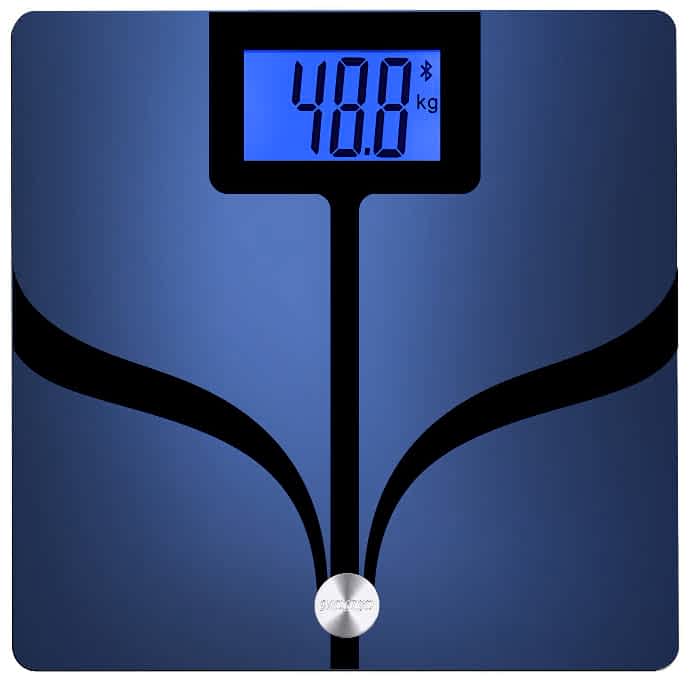
One great tip I can give you is to if you’re exercising and restricting your caloric intake, I suggest that you get a body-composition scale that sends data to your smartphone.
I have the Tanita BC1000+, for which I paid about $300 about 5 years ago. It’s a great scale and sends lots of data to my PC. There I have a program which shows graphs of how my measurements look over time. It measures weight, body mass, body fat %, body water %, muscle mass, bone mass, visceral fat and shows my BMI.
They still sell the Tanita scale I have, but these days you can get a smartphone-enabled scale for less than 1/3 of what I paid. You can go to Amazon, and do a search for “body composition scales – smartphone”, and you’ll see more than 20 of them.
I didn’t see any familiar brands, so if you’re going to buy here, I suggest you check the ratings people give, and look for 4 stars or better. You might be able to buy one at a brick and mortar store too, and it would be easier to return if you had issues.
Now…why do I suggest this type of scale?
For several reasons.
The first and most important is that you can monitor your body fat and muscle. Let me give you a scenario here. Suppose you just have a scale that shows your weight.
You’re working out 3 days a week with kettlebells, doing cardio with a fanbike, and feeling pretty-good. But after a month, your scale shows that you’ve only dropped a couple of pounds, and you’re thinking like “What’s the point”, even though you are feeling better. You’re feeling discouraged and might just cut back and take it easy if it’s not helping.
Now, let’s suppose that what has happened in that month is that you’ve actually gained 4 pounds of muscle, and lost 6 pounds of fat, which equals that 2 pound loss. You’d be really excited, and encouraged to stay on your program and maybe even turn it up a bit.
See what I mean?
In addition, you will be able to be sure you’re properly hydrated, if your visceral fat (around your organs) is dropping and all kinds of information that can encourage you.
Many studies have shown that when you workout really hard, your body will make you hungrier, and you may just wind up eating enough calories to negate your weightloss, so be aware of this.
Here’s an example: If you weigh 180 pounds and you run for 30 minutes on a treadmill, you will burn up around 368 calories. But if you eat only 1 cup of ice cream (not much), you will gain back 275 calories.
The standard rule is that 3,500 calories equals 1 pound, so technically, if you did this for more than a month, you might lose 1 pound. Do want to work that hard to lose a pound a month? Please do work that hard to help your health, but not for weightloss by itself. Here’s a great calorie-counter: http://www.webmd.com/diet/healthtool-fitness-calorie-counter
On the other hand, every person is different, and in one experiment from 1999, 16 individuals were fed an excess of 1,000 calories per day for eight weeks. Eating this amount of additional calories would total 56,000. Since the common belief an additional 3,500 calories leads to a pound of weight gain, every subject should have gained 16 pounds. It didn’t shake out that way at all. Subjects’ weight gain ranged from as little as about 3 pounds to as much as 15.9 pounds.
Source: http://www.cheatsheet.com/health-fitness/diet-facts-or-fiction-the-truth-behind-8-nutrition-myths.html/?a=viewall
Reports by people who have succeeded in keeping weight off tend to have a common theme of constant vigilance, keeping close track of weight, controlling what food is eaten and how much (often by weighing and measuring food), exercising often and resisting cravings to the best of their ability.
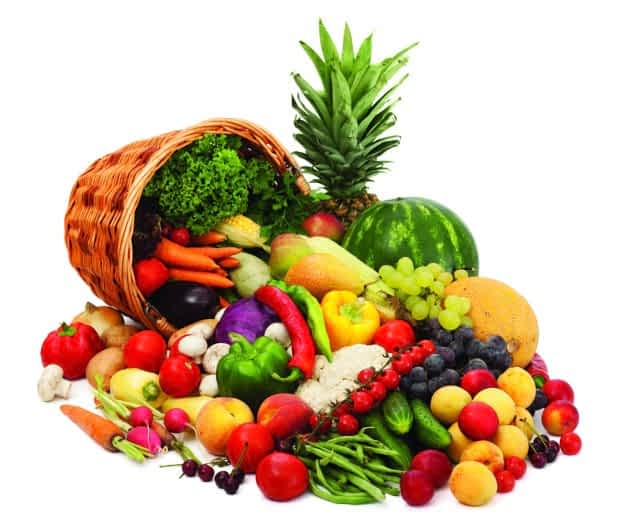
One of the biggest changes you can make when it comes to losing weight in a safe and sane way, is centered around the way you make personal choices.
As a matter of fact, the issue of making changes in your life is almost completely about choice, although many (most?) of us act in unconscious ways, just doing what we’ve always done. Learn how to make healthy choices instead of keeping on with the options and choices that have led you to the overweight place you may be right now.
In addition, this isn’t just about “losing weight”. It’s about feeling great and healthy, about having the energy to do the things you want to do. Do you want to be too tired to play with your grandkids? How about you and your partner both losing weight and exercising together? You might find yourself in a closer relationship.
There may be no point is blaming yourself for any poor choices you have made up to this point, and some people are quite comfortable with their level of health and weight. But if you are not happy with the way you feel or the way you look, and you want to change, then learning how to make different choices is a good first step.
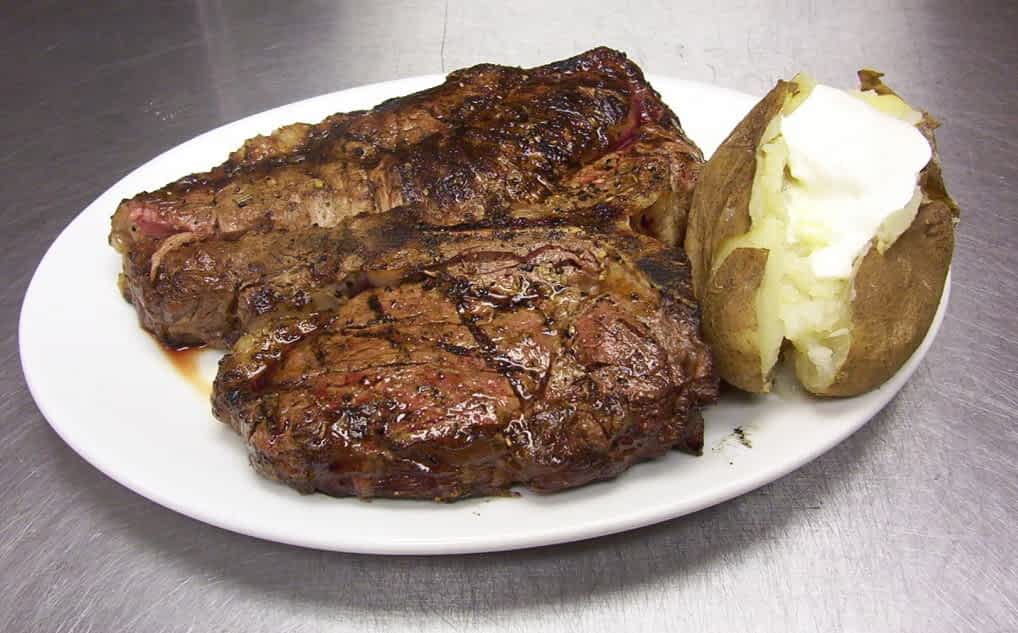
When you were growing up, the habits of the people around you, like those of your parents, often became your choices in life as well. No blame there, they were only doing the best they could with what they knew how to do.
Sometimes, those were the only choices that were available at the time. It’s not like when you are a small child that you are going to tell your mom that the food she is giving you is not healthy for you. You are pretty much just going to eat it.
Of course, there are always some kids who throw tantrums at mealtimes, but for the most part, you learn to eat what you are given to eat. As a result of this choice on the part of somebody else, you believed that these choices were the correct ones. If those choices included lots of good healthy food, then you probably grew up with a healthy body weight.
But if the food you were provided as a child was high fat, or high calorie or high in refined carbohydrates, then you felt that those were the correct food choices to make. But now maybe those choices don’t serve you anymore. Time to try out a new set of food choices that can help you in your quest for losing weight and feeling great. So here are some new options that you can try to help you release some of that extra weight.
New Choice #1
Include some sources of protein that are not meat with your meals. Your body goes through different steps to metabolize and release the nutrients in each of those foods. What happens is that nutrients like amino acids help your body perform well. So you want to eat sources of protein that burn cleanly in your body and have fewer calories. They can include beans and peas, as well as other plant-based foods. See the nutrition section of this course for more info.
New Choice #2
At least once a week, try having a meatless lunch and dinner. These two meals don’t have to be on the same day, but they certainly can be. A lot of people have grown up with the idea that if it doesn’t have meat in it, it’s not a meal. And that is just not true.
A meal does not have to include meat and in many parts of the world, meat is served at only one meal a day and sometimes no meals during the day, and maybe as little as once a week. If you are looking for an easy kind of choice to make in your eating habits, this could be one to try.
There is no reason why you can’t have a meal with whole grains, fruits, vegetables and legumes, which include things like beans and split peas. Legumes have a fair amount of protein in them.
And if you don’t have things like pork and beans, but instead make your meal of chili without meat or something like split pea soup with no ham, you will still feel very full. You will get a good nutritious meal and you will have eaten way less calories of fat than you would if you had meat.
These choices are actually pretty easy to make in your life, and if you really want to lose weight in a non-suffering way, try a couple of these changes and you will be quite pleasantly surprised with the results.
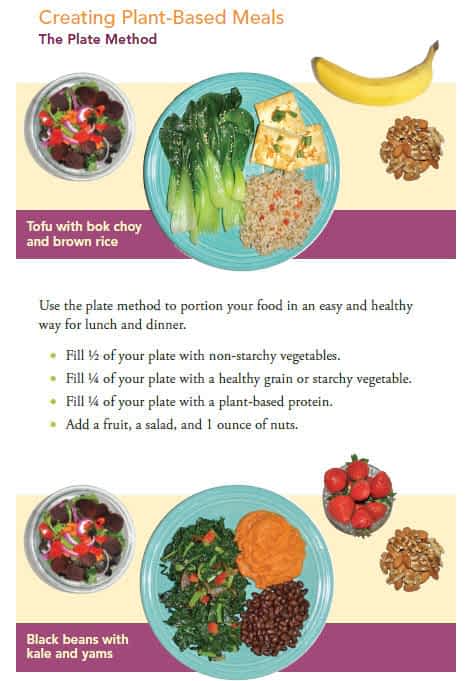
Here’s one way to decide what to eat for your meals, called “The Plate Method”. It’s from the new Kaiser Permanente eBook titled “The Plant-Based Diet”. You can download it by clicking here.
Use the “Plate Method” to portion your food in an easy and healthy way for lunch and dinner.
● Fill ½ of your plate with non-starchy vegetables.
(No potatoes, squash or green peas.)
● Fill ¼ of your plate with a healthy whole grain (brown rice, barley, etc.) or starchy vegetable like sweet potatoes.
● Fill ¼ of your plate with a plant-based protein. This would include beans, peas and seeds. Also included are foods such as tofu, tempeh, seitan and “fake” meats such as veggie burgers, veggie sausages, etc.
● Add a fruit, a salad and 1 ounce of nuts.
Now, don’t get all freaked-out that you’re going to have to live on alfalfa sprouts and distilled water. To start with, if you have a meal like the above one, you’ll feel pretty-full.
In addition, this, like everything else on our site, is not an “all or nothing” deal. You can start by cutting down the portion size of the meat in your meal, and adding in, or increasing, the portion size of one or more of the other elements.
Recipe Resources
https://spoonuniversity.com/lifestyle/29-vegetarian-dinners-thatll-actually-fill-you-up
https://spoonuniversity.com/lifestyle/33-vegetarian-meals-that-will-make-you-forget-meat-exists/

Here’s a great article on losing weight by following a plant-based diet:
http://eatdrinkbetter.com/2015/05/23/healthy-weight-loss-on-a-vegan-diet/
In addition, there are many plant-based meat and dairy substitutes that you can try out. I have been following a vegetarian diet for most of the past 50 years, and a vegan diet (no animal products including diary and eggs) and have tried lots of fake meats Some are pretty-bad. Others are great.
Try this: in the morning, have a slice of Dave’s Killer 21 Grains and Seeds bread, with some Daiya “cream cheeze style spread”. This stuff is epic!
Then, later in the day, have a slice of Daiya “cheeze” slices, which comes in flavors of American, cheddar, Swiss and provolone. Try putting it veggieburger sandwich (with Dave’s Killer Thin-Sliced bread). I put the “burger” in the microwave for about 1/2 of the cooking cycle, and then put the slice of cheeze on top. Back into the micro for the rest of the cycle, and then eat and enjoy!
For a meat substitute, there are products made from wheat called “seitan”. They can have a great meaty-texture, and absorb flavors well. I like a few different brands, but I suggest you see what’s at your local health-food store and try some out to see which ones you like.
Also try some of the Tofurky sausages, including the “Artisan” ones, which include beer brats, kielbasa and spinach-pesto. Morningstar Farms and Gardein also have faux meats, and (here in Southern California) can be found in health food stores, and even Walmart!
You will likely have to change some of the foods you eat, including possibly some of your favorites. But you will find new foods to eat, and some of those may become your new favorites.
Some changes may not be easy at first, but the reward will be the way you will feel and feel about yourself when you have lost weight and have the energy you’ve always wanted to have.
You’ll be dropping refined foods that have never been good for your body, regardless of whether they put weight on you or not. You’ll be replacing them with whole foods which you will learn to enjoy.
After you have eaten minimally processed foods for a period of time, if you again try to eat a Twinkie, you’ll likely find the taste repulsive.
So please go over to the Good Nutrition section of this course to learn more about a healthy diet and how it can make you feel better than you maybe have felt in years.
On my Website at GreatMiddleAge.com, I regularly put up new articles on easier ways to get fit and lose weight, so be sure to go there from time to time and check them out. Of course, if you sign up for my newsletter, you’ll get lots of great info delivered to your inbox regularly. Click on this link now to get connected: https://greatmiddleage.com/newsletter/. Or you can always just click on the “Newsletter” link on GreatMiddleAge.com.
Also, there are a lot of ways to make losing unwanted weight easier. Check this out: In a small recent study, researchers at the University of Birmingham in the UK found that, on average, people who drank a glass of water 30 minutes before some or all of their three meals a day lost between 5 and 9 pounds over the course of about three months.
Or, how about this: Eating food on a large plate with large utensils will cause you to eat more, so get some smaller plates and forks and spoons, and make it easier on yourself.
Here are a few things I do to keep my weight down and have better health and energy.
Don’t eat if you’re not hungry. I know that some people say you should have a regular mealtime, etc., and there may be some truth to that, but to me it makes no sense to sit down and eat if you’re not hungry, but to wait until you are hungry before you eat.
If you’re in a living situation where you eat when others do, such as with your family or at work, then only eat as much as you feel you need to and stop eating a bit before you’re full.
If you’re eating at home, among other things, use a scale to portion your food. I have at times made oatmeal for a late-morning breakfast, but noticed that I was feeling very full when I finished, even though I was only eating the ½ cup (dried) that was shown as “1 serving” on the box, which weighed out at 50 grams to start.
I then cut that down to 45 grams, but still felt stuffed, so I cut it down to 40 grams, which leaves me full, but not stuffed, and with better energy. As I mention above, in addition to the oatmeal, I mix in other food items such as 40 grams of spinach, one slice of Daiya vegan cheese, ½ vegan sausage and 1 tablespoon Earth Balance spread. My point is to finish eating and not feel “stuffed”.
Here’s a good article on weightloss:
http://www.nytimes.com/2016/05/05/health/short-answers-to-hard-questions-about-weight-loss.html
Now that you’re happy and healthy, it’s time to get some money in your bank account from using what I show you in the Financial Abundance section, of this course.